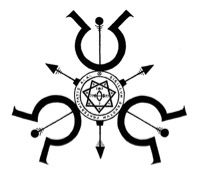Sigil
Origin
late Middle English: from late Latin sigillum ‘sign.’ It may also be related to the Hebrew סגולה (segula meaning "word, action, or item of spiritual effect, talisman"). The current use of the term is derived from Renaissance magic, which was in turn inspired by the magical traditions of antiquity.
Definitions
- 1: An inscribed or painted symbol considered to have magical power.
- 2: archaic a seal: the supply wains bore the High King's sigil.
- 3: literary a sign or symbol.
Description
A sigil pl. sigilia or sigils; from Latin sigillum "seal") is a symbol used in magic. The term has usually referred to a type of pictorial signature of a demon or other entity; in modern usage, especially in the context of chaos magic, it refers to a symbolic representation of the magician's desired outcome.
In medieval ceremonial magic, the term sigil was commonly used to refer to occult signs which represented various angels and demons which the magician might summon. The magical training books called grimoires often listed pages of such sigils. A particularly well-known list is in The Lesser Key of Solomon, in which the sigils of the 72 princes of the hierarchy of hell are given for the magician's use. Such sigils were considered to be the equivalent of the true name of the spirit and thus granted the magician a measure of control over the beings.
A common method of creating the sigils of certain spirits was to use kameas (magic squares) — the names of the spirits were converted to numbers, which were then located on the magic square. The locations were then connected by lines, forming an abstract figure.
The use of symbols for magical or cultic purposes has been widespread since at least the Neolithic era. Some examples from other cultures include the yantra from Hindu tantra, historical runic magic among the Germanic peoples, or the use of veves in Voudon.[1]
In computer programming, a sigil plural sigilia or sigils) is a symbol attached to a variable name, showing the variable's datatype or scope, usually a prefix, as in $foo, where $ is the sigil.[2]
